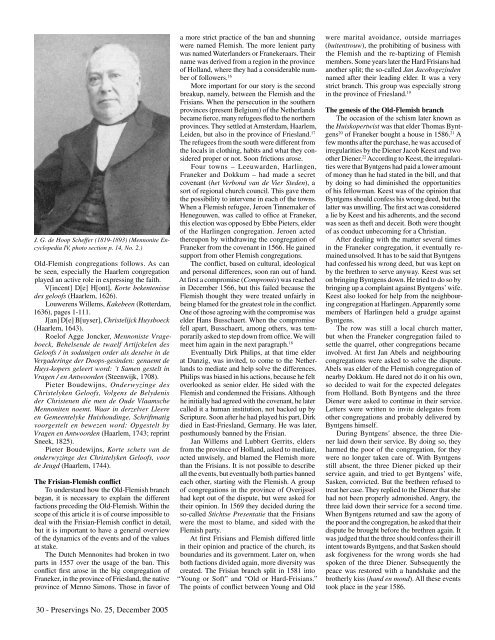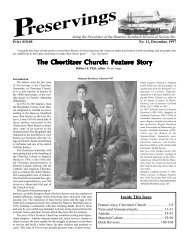Preservings $20 No. 25, December, 2005 - Plett Foundation
Preservings $20 No. 25, December, 2005 - Plett Foundation
Preservings $20 No. 25, December, 2005 - Plett Foundation
You also want an ePaper? Increase the reach of your titles
YUMPU automatically turns print PDFs into web optimized ePapers that Google loves.
J. G. de Hoop Scheffer (1819-1893) (Mennonite Encyclopedia<br />
IV, photo section p. 14, <strong>No</strong>. 2.)<br />
Old-Flemish congregations follows. As can<br />
be seen, especially the Haarlem congregation<br />
played an active role in expressing the faith.<br />
V[incent] D[e] H[ont], Korte bekentenisse<br />
des geloofs (Haarlem, 1626).<br />
Louwerens Willems, Kakebeen (Rotterdam,<br />
1636), pages 1-111.<br />
J[an] D[e] B[uyser], Christelijck Huysboeck<br />
(Haarlem, 1643).<br />
Roelof Agge Joncker, Mennoniste Vrageboeck,<br />
Behelsende de twaelf Artijckelen des<br />
Geloofs / in sodanigen order als deselve in de<br />
Vergaderinge der Doops-gesinden: genaemt de<br />
Huys-kopers geleert word: ’t Samen gestelt in<br />
Vragen / en Antwoorden (Steenwijk, 1708).<br />
Pieter Boudewijns, Onderwyzinge des<br />
Christelyken Geloofs, Volgens de Belydenis<br />
der Christenen die men de Oude Vlaamsche<br />
Mennoniten noemt. Waar in derzelver Lleere<br />
en Gemeentelyke Huishoudinge, Schriftmatig<br />
voorgestelt en bewezen word: Opgestelt by<br />
Vragen en Antwoorden (Haarlem, 1743; reprint<br />
Sneek, 18<strong>25</strong>).<br />
Pieter Boudewijns, Korte schets van de<br />
onderwyzinge des Christelyken Geloofs, voor<br />
de Jeugd (Haarlem, 1744).<br />
The Frisian-Flemish conflict<br />
To understand how the Old-Flemish branch<br />
began, it is necessary to explain the different<br />
factions preceding the Old-Flemish. Within the<br />
scope of this article it is of course impossible to<br />
deal with the Frisian-Flemish conflict in detail,<br />
but it is important to have a general overview<br />
of the dynamics of the events and of the values<br />
at stake.<br />
The Dutch Mennonites had broken in two<br />
parts in 1557 over the usage of the ban. This<br />
conflict first arose in the big congregation of<br />
Franeker, in the province of Friesland, the native<br />
province of Menno Simons. Those in favor of<br />
30 - <strong>Preservings</strong> <strong>No</strong>. <strong>25</strong>, <strong>December</strong> <strong>2005</strong><br />
a more strict practice of the ban and shunning<br />
were named Flemish. The more lenient party<br />
was named Waterlanders or Franekeraars. Their<br />
name was derived from a region in the province<br />
of Holland, where they had a considerable number<br />
of followers. 16<br />
More important for our story is the second<br />
breakup, namely, between the Flemish and the<br />
Frisians. When the persecution in the southern<br />
provinces (present Belgium) of the Netherlands<br />
became fierce, many refugees fled to the northern<br />
provinces. They settled at Amsterdam, Haarlem,<br />
Leiden, but also in the province of Friesland. 17<br />
The refugees from the south were different from<br />
the locals in clothing, habits and what they considered<br />
proper or not. Soon frictions arose.<br />
Four towns – Leeuwarden, Harlingen,<br />
Franeker and Dokkum – had made a secret<br />
covenant (het Verbond van de Vier Steden), a<br />
sort of regional church council. This gave them<br />
the possibility to intervene in each of the towns.<br />
When a Flemish refugee, Jeroen Tinnemaker of<br />
Henegouwen, was called to office at Franeker,<br />
this election was opposed by Ebbe Pieters, elder<br />
of the Harlingen congregation. Jeroen acted<br />
thereupon by withdrawing the congregation of<br />
Franeker from the covenant in 1566. He gained<br />
support from other Flemish congregations.<br />
The conflict, based on cultural, ideological<br />
and personal differences, soon ran out of hand.<br />
At first a compromise (Compromis) was reached<br />
in <strong>December</strong> 1566, but this failed because the<br />
Flemish thought they were treated unfairly in<br />
being blamed for the greatest role in the conflict.<br />
One of those agreeing with the compromise was<br />
elder Hans Busschaert. When the compromise<br />
fell apart, Busschaert, among others, was temporarily<br />
asked to step down from office. We will<br />
meet him again in the next paragraph. 18<br />
Eventually Dirk Philips, at that time elder<br />
at Danzig, was invited, to come to the Netherlands<br />
to mediate and help solve the differences.<br />
Philips was biased in his actions, because he felt<br />
overlooked as senior elder. He sided with the<br />
Flemish and condemned the Frisians. Although<br />
he initially had agreed with the covenant, he later<br />
called it a human institution, not backed up by<br />
Scripture. Soon after he had played his part, Dirk<br />
died in East-Friesland, Germany. He was later,<br />
posthumously banned by the Frisian.<br />
Jan Willems and Lubbert Gerrits, elders<br />
from the province of Holland, asked to mediate,<br />
acted unwisely, and blamed the Flemish more<br />
than the Frisians. It is not possible to describe<br />
all the events, but eventually both parties banned<br />
each other, starting with the Flemish. A group<br />
of congregations in the province of Overijssel<br />
had kept out of the dispute, but were asked for<br />
their opinion. In 1569 they decided during the<br />
so-called Stichtse Presentatie that the Frisians<br />
were the most to blame, and sided with the<br />
Flemish party.<br />
At first Frisians and Flemish differed little<br />
in their opinion and practice of the church, its<br />
boundaries and its government. Later on, when<br />
both factions divided again, more diversity was<br />
created. The Frisian branch split in 1581 into<br />
“Young or Soft” and “Old or Hard-Frisians.”<br />
The points of conflict between Young and Old<br />
were marital avoidance, outside marriages<br />
(buitentrouw), the prohibiting of business with<br />
the Flemish and the re-baptizing of Flemish<br />
members. Some years later the Hard Frisians had<br />
another split; the so-called Jan Jacobsgezinden<br />
named after their leading elder. It was a very<br />
strict branch. This group was especially strong<br />
in the province of Friesland. 19<br />
The genesis of the Old-Flemish branch<br />
The occasion of the schism later known as<br />
the Huiskopertwist was that elder Thomas Byntgens<br />
20 of Franeker bought a house in 1586. 21 A<br />
few months after the purchase, he was accused of<br />
irregularities by the Diener Jacob Keest and two<br />
other Diener. 22 According to Keest, the irregularities<br />
were that Byntgens had paid a lower amount<br />
of money than he had stated in the bill, and that<br />
by doing so had diminished the opportunities<br />
of his fellowman. Keest was of the opinion that<br />
Byntgens should confess his wrong deed, but the<br />
latter was unwilling. The first act was considered<br />
a lie by Keest and his adherents, and the second<br />
was seen as theft and deceit. Both were thought<br />
of as conduct unbecoming for a Christian.<br />
After dealing with the matter several times<br />
in the Franeker congregation, it eventually remained<br />
unsolved. It has to be said that Byntgens<br />
had confessed his wrong deed, but was kept on<br />
by the brethren to serve anyway. Keest was set<br />
on bringing Byntgens down. He tried to do so by<br />
bringing up a complaint against Byntgens’ wife.<br />
Keest also looked for help from the neighbouring<br />
congregation at Harlingen. Apparently some<br />
members of Harlingen held a grudge against<br />
Byntgens.<br />
The row was still a local church matter,<br />
but when the Franeker congregation failed to<br />
settle the quarrel, other congregations became<br />
involved. At first Jan Abels and neighbouring<br />
congregations were asked to solve the dispute.<br />
Abels was elder of the Flemish congregation of<br />
nearby Dokkum. He dared not do it on his own,<br />
so decided to wait for the expected delegates<br />
from Holland. Both Byntgens and the three<br />
Diener were asked to continue in their service.<br />
Letters were written to invite delegates from<br />
other congregations and probably delivered by<br />
Byntgens himself.<br />
During Byntgens’ absence, the three Diener<br />
laid down their service. By doing so, they<br />
harmed the poor of the congregation, for they<br />
were no longer taken care of. With Byntgens<br />
still absent, the three Diener picked up their<br />
service again, and tried to get Byntgens’ wife,<br />
Sasken, convicted. But the brethren refused to<br />
treat her case. They replied to the Diener that she<br />
had not been properly admonished. Angry, the<br />
three laid down their service for a second time.<br />
When Byntgens returned and saw the agony of<br />
the poor and the congregation, he asked that their<br />
dispute be brought before the brethren again. It<br />
was judged that the three should confess their ill<br />
intent towards Byntgens, and that Sasken should<br />
ask forgiveness for the wrong words she had<br />
spoken of the three Diener. Subsequently the<br />
peace was restored with a handshake and the<br />
brotherly kiss (hand en mond). All these events<br />
took place in the year 1586.

















